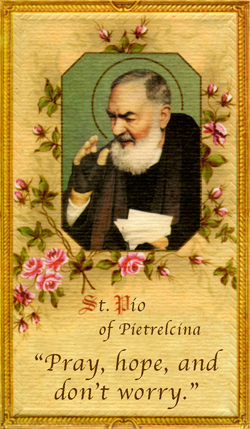 Dear Brothers and Sisters,
Dear Brothers and Sisters,
It is a great joy for me to meet you again in this square which yesterday witnessed an event which you have waited so long for – the beatification of Padre Pio of Pietrelcina. Today is the day of thanksgiving.
The solemn Eucharistic celebration, at which Cardinal Angelo Sodano, my Secretary of State, presided, ended a short while ago. I offer him a cordial greeting, which I extend to each of the other Cardinals and Bishops present, as well as to the many priests and faithful taking part.
Dear Capuchin Friars, I embrace you with special affection, as I do the other members of the great Franciscan family who are praising the Lord for the marvels he worked in the humble friar of Pietrelcina, an exemplary follower of the Poor Man of Assisi. Many of you, dear pilgrims, are members of prayer groups founded by Padre Pio. I greet you affectionately together with all the other faithful who, prompted by their devotion to the new blessed, have wished to be here on this joyful occasion. Lastly, I would like to extend a special greeting to all the sick. You were dear to Padre Pio’s heart and work. Thank you for your treasured presence.
Divine Providence wanted Padre Pio to be beatified on the eve of the Great Jubilee of the Year 2000, as a dramatic century draws to a close. What is the message that the Lord would like to offer to believers and to all humanity with this event of major spiritual importance?
Padre Pio’s witness, which is evident from his life and even from his physical condition, suggests to us that this message coincides with the essential meaning of the Jubilee now close at hand. Jesus is the one Savior of the world. In him, God’s mercy was made flesh in the fullness of time, to bring salvation to humanity mortally wounded by sin. “By his wounds you have been healed” (1 Pt 2:24), the blessed father repeated to all in the words of the Apostle Peter, he whose own body was marked with those wounds.
In 60 years of religious life, practically all spent at San Giovanni Rotondo, he was totally dedicated to prayer and to the ministry of reconciliation and spiritual direction. This was well emphasized by the Servant of God, Pope Paul VI: “Look what fame he had…. But why?… Because he said Mass humbly, heard confessions from dawn to dusk and was … the one who bore the wounds of our Lord. He was a man of prayer and suffering” (February 20, 1971).
Totally absorbed in God, always bearing the marks of Jesus’ Passion in his body, he was bread broken for men and women starving for God the Father’s forgiveness. His stigmata, like those of Francis of Assisi, were the work and sign of Divine Mercy, which redeemed the world by the Cross of Jesus Christ. Those open, bleeding wounds spoke of God’s love for everyone, especially for those sick in body and spirit.
And what can be said of his life, an endless spiritual combat, sustained by the weapons of prayer, centered on the sacred daily acts of Confession and Mass? Holy Mass was the heart of his whole day, the almost anxious concern of all his hours, his moment of closest communion with Jesus, Priest and Victim. He felt called to share in Christ’s agony, an agony which continues until the end of the world.
Dear friends, in our time, when we are still under the illusion that conflicts can be resolved by violence and superior strength, and when many frequently give in to the temptation to abuse the force of arms, Padre Pio repeats what he once said, “What a dreadful thing war is! In every person wounded in the flesh, there is Jesus suffering.” Nor should we fail to note that both his works ‘” the “Home for the Relief of Suffering” and the prayer groups ‘” were conceived by him in 1940, as the catastrophe of the Second World War loomed in Europe. He was not idle, but from his secluded friary in Gargano he responded with prayer, works of mercy and love for God and neighbor. And today, from heaven, he is telling everyone again that this is the authentic way of peace.
The prayer groups and the “Home for the Relief of Suffering,” these are two significant gifts which Padre Pio has left us. Conceived and desired by him as a hospital for the sick poor, the “Home for the Relief of Suffering” was planned from the start as a health care facility open to everyone, but this was no reason for it to be less equipped than other hospitals. Indeed, Padre Pio wanted it to have the most advanced scientific and technological equipment, so that it would be a place of authentic hospitality, loving respect and effective treatment for every suffering person. Is it not a true miracle of Providence that it continues to grow in accordance with its founder’s spirit?
As for the prayer groups, he wanted them to be like beacons of light and love in the world. He longed for many souls to join him in prayer. “Pray”, he used to say, “pray to the Lord with me, because the whole world needs prayers. And every day, when your heart especially feels the loneliness of life, pray. Pray to the Lord together, because God too needs our prayers.” It was his intention to create an army of praying people who would be a “leaven” in the world by the strength of prayer. And today the whole Church is grateful to him for this precious legacy, admires the holiness of her son and invites everyone to follow his example.
Dear brothers and sisters, Padre Pio’s witness is a powerful call to the supernatural dimension, not to be confused with exaggerated concern for miracles, a deviation which he always and resolutely shunned. Priests and consecrated persons in particular should look to him.
He teaches priests to become the docile and generous instruments of Divine grace, which heals people at the root of their ills, restoring peace of heart to them. The altar and the confessional were the two focal points of his life. The charismatic intensity with which he celebrated the divine mysteries is a very salutary witness, to shake priests from the temptation of habit and help them rediscover, day by day, the inexhaustible treasure of spiritual, moral and social renewal which is placed in their hands.
To consecrated persons and especially to the Franciscan family, he offers a witness of extraordinary fidelity. Francis was his baptismal name, and he was a worthy follower of the Seraphic Father in poverty, chastity and obedience from the time he first entered the friary. He practiced the Capuchin rule in all its rigor, generously embracing the life of penance. He found no gratification in pain but chose it as a way of expiation and purification. Like the Poor Man of Assisi, he aimed at conformity with Jesus Christ, desiring only “to love and to suffer,” in order to help the Lord in the exhausting and demanding work of salvation. In “firm, constant, and iron” obedience (Letter I, p. 488), he found the highest expression of his unconditional love for God and the Church.
What a consolation to feel we have Padre Pio close to us, one who only wanted to be “a poor friar who prays,” a brother of Christ, a brother of Francis, a brother of the suffering, a brother of each one of us. May his help guide us on the way of the Gospel and make us ever more generous in following Christ.
May the Blessed Virgin Mary, whom he loved and helped others to love with profound devotion, obtain this for us. May his intercession, which we confidently invoke, obtain this for us.
I accompany these hopes with my Apostolic Blessing, which I cordially impart to you, dear pilgrims present here, and to all who are united in spirit with our festive gathering.
Pope John Paul II
This speech was given in Rome on May 3, 1999, the day following the beatification of Padre Pio.





